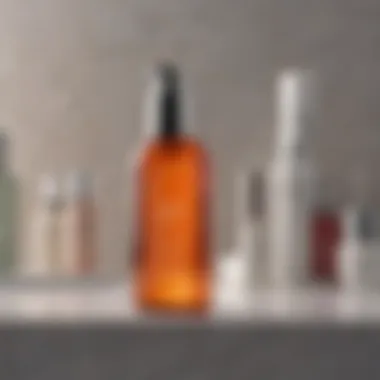Top Treatments for Broken Capillaries on the Face


Intro
Broken capillaries, or telangiectasia, are small, dilated blood vessels that appear close to the surface of the skin, often on the face. They can be triggered by a variety of factors, including sun exposure, aging, and skin sensitivity. The presence of these capillaries may lead to discomfort and self-consciousness in many individuals. For those seeking solutions, a wide array of products and treatments exist. This article aims to dissect the most effective options available, empowering readers with the knowledge to tackle this issue with confidence.
Tips and How-Tos
When addressing broken capillaries, understanding the best skincare practices tailored to various skin types can significantly enhance the effectiveness ofchosen products.
Skincare Routines for Different Skin Types
- Sensitive Skin: For people with sensitive skin, it’s vital to use gentle formulations. Look for products with chamomile or aloe vera, which reduce redness and discomfort. Avoid harsh chemicals like alcohols that can aggravate the skin.
- Dry Skin: Those with dry skin benefit from hydrating ingredients. Products containing hyaluronic acid or glycerin help to retain moisture, which soothes the appearance of broken capillaries. Regular use of thick creams provides a protective barrier against environmental factors.
- Oily Skin: A lightweight, oil-free moisturizer is essential for oily skin. Ingredients like salicylic acid can help minimize pore size, while niacinamide can assist in reducing inflammation.
- Combination Skin: A balanced approach is necessary for combination skin. Use a targeted treatment for affected areas and a hydrating formula for dry patches. Vitamin C serums can be beneficial for overall skin tone and texture.
Additional Tips
- Sun Protection: Always apply sunscreen daily, as UV exposure can worsen the appearance of broken capillaries.
- Gentle Cleansing: Use a mild cleanser to avoid stripping the skin of its natural oils, preserving its barrier function.
- Hydration: Regularly hydrate your skin from within by drinking plenty of water and consuming a balanced diet.
"A consistent skincare routine tailored to your skin type can make a substantial difference in managing broken capillaries."
Sustainable Practices
While seeking solutions for broken capillaries, it is also crucial to consider the sustainability of the products used. Choose brands that prioritize eco-responsibility in their formulations and packaging. Here are a few practices:
- Research Brands: Look for skincare products from companies that utilize renewable resources and limit their carbon footprint.
- Reduce Waste: Select items with minimal or recyclable packaging.
Celebrating Diversity in Beauty
Beauty is not a one-size-fits-all concept. Inclusivity in beauty products is gaining importance. Diverse brands cater to various skin tones and needs, including those affected by broken capillaries.
- Inclusive Beauty Brands: Brands like Fenty Beauty and Rare Beauty have set examples by offering extensive shade ranges and products that address unique skincare issues.
- Cultural Influences on Fashion: Different cultures have unique approaches to skincare. Understanding these can offer insights into potential remedies and treatments for broken capillaries.
Engaging with these diverse perspectives can enhance one’s approach to skincare, recognizing that beauty and health practices vary widely, yet all aim toward achieving well-being and confidence.
Understanding Broken Capillaries
Understanding broken capillaries is essential for anyone looking to address this common skin concern. These small, dilated blood vessels often appear on the face, especially around the nose, cheeks, and chin. They can lead to a visible reddish or purplish tint on the skin, which can be distressing for many individuals. This section will cover what broken capillaries are, their causes, and how to identify them, giving readers foundational knowledge as they explore treatment options.
What are Broken Capillaries?
Broken capillaries, also known as telangiectasia, are tiny blood vessels that become prominent near the surface of the skin. This can happen due to various factors, such as aging, sun damage, or skin trauma. When capillaries break, they may cause redness and visible lines, which can be found on various parts of the face. These vessels are highly sensitive and can react to environmental stimuli, leading to further skin irritation.
Causes of Broken Capillaries
Several factors contribute to the development of broken capillaries. Common causes include:
- Sun Exposure: UV rays can weaken skin and small blood vessels, making them more likely to break.
- Skin Trauma: Injuries or harsh treatments can damage the skin, affecting capillary integrity.
- Genetic Predisposition: Some individuals may have a hereditary tendency to develop broken capillaries.
- Rosacea: This chronic skin condition is associated with redness, flushing, and weakened capillary walls.
- Alcohol Consumption: Alcohol can cause blood vessels to expand, which may lead to leakage over time.
Understanding these causes can help individuals take preventive measures and make informed decisions when choosing products.
Symptoms and Identification
Identifying broken capillaries involves observing certain symptoms:
- Visible Red or Purple Lines: The most common sign, these may appear on various areas of the face.
- Sensitivity: The affected area may feel sensitive to the touch or irritated.
- Flushed Appearance: Flushing can occur due to environmental triggers or emotions.
If you notice any of these symptoms, it may indicate broken capillaries. Understanding these signs assists in seeking appropriate treatment and in choosing effective products.


Understanding and identifying broken capillaries is crucial as it can greatly impact how individuals approach treatment options and skincare routines. A clear grasp of the condition allows for better management and care.
Importance of Treatment
The treatment of broken capillaries is critical for both psychological and physical reasons. Individuals struggling with this issue often experience a range of emotions, from frustration to embarrassment. Addressing broken capillaries not only improves skin appearance but also enhances overall self-confidence. Without appropriate treatment, these visible capillaries can lead to longer-term emotional effects, possibly affecting personal and professional interactions.
Impact on Self-Image
Broken capillaries can significantly impact an individual's self-perception. The presence of red or blue lines on the face may cause feelings of self-consciousness. Many people perceive their skin as flawed, which can hinder social interactions. Studies suggest that those with visible skin conditions often report lower self-esteem and more social anxiety.
Furthermore, skin problems can lead to feelings of isolation. Individuals may withdraw from social activities, avoiding situations where their skin will be on display. This behavior can exacerbate negative feelings toward oneself. Treatment options vary and can include both topical solutions and procedural interventions.
The act of seeking treatment can itself be empowering. It demonstrates a proactive approach to self-care and can foster a sense of control over one’s appearance.
Improving the appearance of your skin has a profound effect on how you feel about yourself.
Long-Term Skin Health
Beyond just addressing appearance, treating broken capillaries contributes to the overall health of the skin. If left untreated, broken capillaries may lead to further vascular issues and skin deterioration over time. Treating them early can prevent complications that might require more aggressive treatment later.
Well-formulated products can help to strengthen the skin’s capillaries, improving skin resilience and reducing the likelihood of new breakage. Ingredients that promote circulation and skin repair, such as Vitamin K and Niacinamide, are often found in effective treatments. These elements work together to support capillary health and encourage a more even skin tone.
Types of Products for Broken Capillaries
Understanding the types of products available for treating broken capillaries is essential for anyone seeking effective solutions. Broken capillaries, often characterized by their noticeable red or purple hue, can affect one's self-esteem and skin appearance. A variety of treatment options exist, each with their benefits and limitations. This section aims to categorize these products into topical creams, natural remedies, and more advanced laser treatments, allowing for a comprehensive approach to skin health.
Topical Creams and Serums
Topical creams and serums constitute the first line of defense against broken capillaries. These products are designed to be applied directly onto the skin, focusing on the affected areas. The primary benefits of topical treatments include their ease of use and targeted application. Formulations often contain key ingredients that can improve skin resilience and reduce redness.
Common ingredients in these products often include Vitamin K, which is known for its potential to strengthen capillaries, alongside niacinamide, which can calm redness. When selecting a topical cream or serum, it's valuable to research user reviews to gain insights on their efficacy. Users often report noticeable improvements within weeks, although consistent application is vital for optimal results.
Natural Remedies
Natural remedies provide an alternative for individuals who prefer holistic approaches. Many of these remedies leverage the power of herbs and oils that have soothing properties. Some popular natural solutions may include chamomile, green tea extract, and arnica, known for their anti-inflammatory characteristics.
Using these remedies can offer additional benefits, such as reduced irritation and enhanced skin nourishment. For instance, green tea not only combats redness but also adds antioxidant protection. However, it is crucial to perform a patch test when trying any new natural remedy to avoid possible skin reactions. While some may find relief through these methods, others may require more potent treatments to achieve their desired results.
Laser Treatments and Procedures
For severe cases of broken capillaries, laser treatments present an advanced and effective option. Laser therapy works by targeting the affected area with concentrated light beams, which help in sealing off broken capillaries beneath the skin without causing damage to the surrounding tissue. This method often yields immediate results, with patients noticing significant improvements after just one or two sessions.
While highly effective, laser treatments do require consultation with a qualified dermatologist to assess suitability. Potential side effects vary but may include temporary redness or swelling. Considering these factors is essential while exploring this course of action.
Key Ingredients to Look For
When seeking effective products for broken capillaries on the face, understanding the key ingredients is crucial. Each ingredient plays a specific role in promoting skin health. They can help fortify capillaries, reduce inflammation, and enhance overall appearance. Knowing which ingredients provide these benefits makes it easier to select products that are effective.
Vitamin K
Vitamin K is well known for its ability to support blood circulation. It is often found in creams specifically aimed at reducing the appearance of broken capillaries. This vitamin has properties that help with healing and can diminish bruising. Using products with Vitamin K can improve the appearance of red and purple marks left by damaged capillaries. The recommended form is topical application, as it directly targets the affected areas.
Retinoids
Retinoids are derivatives of Vitamin A and are highly regarded for their ability to improve skin texture and tone. They work by accelerating cell turnover, which can help to fade the visibility of broken capillaries over time. Regular use of retinoid-formulated products may lead to healthier skin overall. Caution is suggested, especially for users with sensitive skin, as retinoids can cause irritation and dryness.
Niacinamide


Niacinamide is a form of Vitamin B3. It is known for its anti-inflammatory properties. The ingredient helps to strengthen the skin barrier, which is beneficial for individuals with broken capillaries. Moreover, Niacinamide boosts hydration, improving the overall texture of the skin. Products containing Niacinamide may reduce redness as well, making it a valuable addition to skincare routines.
Hyaluronic Acid
Hyaluronic Acid is renowned for its ability to retain moisture. It is a powerful humectant that draws water into the skin, promoting hydration and plumpness. For those dealing with broken capillaries, maintaining hydrated skin helps to enhance its appearance and resilience. Regular use of Hyaluronic Acid can lead to improved skin elasticity and overall healthier skin condition.
Understanding key ingredients and their benefits is essential in choosing the right products for broken capillaries.
By focusing on these specific ingredients, consumers can make informed choices in their quest for effective treatment solutions.
Evaluating Product Efficacy
In the context of treating broken capillaries on the face, evaluating product efficacy is a central aspect that deserves careful attention. The effectiveness of a product can directly impact the management of broken capillaries, which affects not just the physical appearance, but also emotional and psychological well-being. A well-considered evaluation helps consumers make informed choices, minimizing potential disappointment. Additionally, understanding efficacy allows individuals to select products that suit their unique skin needs.
Clinical Studies and Research
Clinical research plays an essential role in the evaluation of skincare products. This research often includes controlled trials that test the effectiveness of various ingredients or formulations against one another or against a placebo. For broken capillaries, studies may focus on specific active components, such as vitamin K, which is commonly cited for its potential to strengthen capillaries and reduce visibility.
Results from such clinical studies can provide a benchmark for how well specific products perform, offering prospective users a scientific basis for decisions. Meta-analyses that summarize multiple studies are particularly valuable. They offer a broader perspective on how the products perform across various populations and skin types, informing users of common outcomes and efficacy rates.
Research can also highlight potential side effects or adverse reactions which consumers should be mindful of before selecting a treatment.
User Reviews and Testimonials
User-generated feedback is a pivotal complement to clinical research. While scientific studies provide a controlled setting, real-world user experiences can offer insights into how products perform under diverse conditions. Testimonials often detail not just the outcomes—like reduction in the appearance of broken capillaries—but also the overall user experience, which includes application, scent, texture, and skin reaction.
When navigating user reviews, it’s valuable to consider the volume and consistency of feedback regarding a specific product. A product with a high number of positive reviews can indicate strong efficacy, but a product with mixed feedback may warrant scrutiny. Particularly for issues of sensitivity, it can be enlightening to see how a wide demographic has responded to similar products. Understanding personal stories behind the ratings can assist potential users in making informed choices that align with their specific skin concerns.
"User experiences provide a nuanced view of efficacy that clinical studies may overlook. They often capture the subtleties of daily skincare routines and environmental factors that come into play."
To conclude, combining findings from clinical studies with user feedback provides a comprehensive view of product efficacy. This multidimensional approach is crucial for effective treatment of broken capillaries, as it empowers individuals to make choices backed by both scientific evidence and real-life experiences.
Product Recommendations
Understanding the various options available for treating broken capillaries on the face is crucial for anyone dealing with this condition. Product recommendations serve as a roadmap for selecting effective treatments that cater directly to individual needs. These recommendations can greatly enhance the efficacy of one’s skincare routine and help alleviate the visible signs of broken capillaries. It is essential to consider factors such as skin type, severity, and personal preferences when choosing products.
Here, you will find a breakdown of top-rated products across three main categories: topical treatments, natural remedies, and innovative laser therapies. This comprehensive approach ensures that readers can make informed choices based on their specific circumstances and goals.
Best Topical Products
Topical products are often the first line of defense against broken capillaries. These solutions are designed to be applied directly to the skin, allowing for targeted treatment. When selecting topical products, look for formulations that include beneficial ingredients specifically aimed at strengthening capillary walls and improving overall skin appearance.
Some recommended brands for topical treatments include:
- La Roche-Posay Rosaliac AR Intense
- Skinceuticals Discoloration Defense
- Niacinamide 10% + Zinc 1% by The Ordinary
Each of these options contains key ingredients that address the symptoms of broken capillaries effectively. For instance, La Roche-Posay incorporates gentleness due its soothing properties, while Skinceuticals offers a more advanced approach with clinically backed results.
Effective Natural Remedies
Natural remedies appeal to individuals who prefer a holistic approach to skincare. Many of these options utilize natural ingredients that can soothe irritated skin and promote healing without harsher chemicals. A few popular natural remedies include:
- Arnica Gel
- Chamomile Extract
- Aloe Vera
These ingredients are renowned for their anti-inflammatory properties and ability to improve skin texture. Using these in your skincare regimen may provide a gentler alternative to traditional topical treatments. They can often be found in over-the-counter formulations or used as DIY remedies depending on personal preference.
Innovative Laser Treatments
For those seeking more advanced solutions, laser treatments can be highly effective in reducing the appearance of broken capillaries. This method works by delivering targeted light therapy to specifically treat damaged capillaries while sparing surrounding tissue. Popular options include:
- Pulsed Dye Laser (PDL)
- Intense Pulsed Light (IPL)


Both treatments help diminish redness and improve skin’s overall appearance. Consulting with a dermatologit is vital to understand which option is best suited for individual skin types and conditions.
These innovative treatments often provide quick results, although multiple sessions may be required for optimal outcome.
Cautions and Considerations
Understanding the potential risks associated with products for broken capillaries is essential. Each individual's skin is unique, and what works for one person may not work for another. Thus, caution must be exercised when choosing treatments. The following sections address two main aspects: skin sensitivity and necessary consultations with dermatologists.
Skin Sensitivity and Reactions
Skin sensitivity varies widely among individuals. Those with broken capillaries may have inherently delicate skin. When selecting products, always conduct a patch test before full application. This test helps to identify any adverse reactions before applying a product to a larger area. Look for signs of redness, itching, or swelling, as these could indicate irritation.
Using high-potency ingredients can lead to increased sensitivity, especially for those already prone to skin redness. It is wise to ease into new products, starting with the lowest concentration, then gradually increasing as tolerated. Be cautious when combining multiple treatments or products to avoid overwhelming the skin.
Consulting with Dermatologists
Asking for professional advice from a dermatologist is often beneficial. Dermatologists can help in understanding the specific causes of broken capillaries and suggest suitable treatments tailored to individual skin types. They can also identify if there are underlying issues contributing to the condition.
Consultation allows for a deeper exploration of treatment options, which may include prescriptions or specialized procedures like laser therapy. These experts can provide insights on product ingredients and their suitability for your skin. Ultimately, an informed decision can significantly improve treatment outcomes.
Regular consultations with dermatologists aid in effective management of broken capillaries and help in adjusting treatment plans as necessary.
In summary, caution in selecting products and consultation with professionals increases the chances of successful treatment for broken capillaries. Taking these precautions ensures safety and promotes skin health.
Maintaining Healthy Skin
Maintaining healthy skin is an essential aspect of overall wellbeing, especially for individuals dealing with broken capillaries on the face. It involves a combination of appropriate skincare practices and a consistent routine to help preserve the skin's integrity. This section examines the importance of maintaining skin health, focusing on its direct impact on the visibility of broken capillaries.
A regular skincare routine contributes not only to the aesthetics of the skin but also to its resilience against various stressors. Healthy skin acts as a barrier to environmental irritants, preventing further damage. Additionally, good skin maintenance can expedite the recovery of weakened capillaries, allowing the skin to restore its natural balance more effectively.
Practicing proper skincare helps build a foundation for healthy skin. This can include moisturizing, gentle cleansing, and sun protection. All these elements work toward reducing the appearance of broken capillaries and improving overall skin tone and elasticity.
Moreover, individuals should consider their unique skin type and the specific needs that arise from broken capillaries. Tailoring one’s routine to include gentle and effective products can minimize irritation and promote healing.
Daily Skincare Routine
A daily skincare routine is a pivotal component of maintaining healthy skin. This routine should be structured to be simple yet effective, focusing on cleansing, treating, and moisturizing.
- Cleansing: Choose a gentle cleanser without harsh chemicals, as these can irritate sensitive skin. Cleansing twice daily helps remove impurities and excess oil.
- Treatment: Incorporate products that contain ingredients tailored to address broken capillaries. Niacinamide and Vitamin K are good choices, as they have been recognized for their soothing and strengthening properties for the skin.
- Moisturizing: Use a hydrating moisturizer that supports skin barrier health. Ingredients such as hyaluronic acid can be beneficial in maintaining moisture levels.
- Sun Protection: Daily sunscreen application is essential to protect against UV damage, which can exacerbate the appearance of broken capillaries. Opt for a broad-spectrum SPF.
Following this daily routine consistently can yield visible improvements over time. It is crucial to be patient and allow the skin to adapt to the changes introduced.
Preventative Measures
Implementing preventative measures can also play a significant role in maintaining skin health and minimizing the risk of developing broken capillaries.
- Avoid Extreme Temperatures: Rapid changes in temperature, whether heat or cold, can cause blood vessels to dilate or contract, leading to potential breakage.
- Limit Alcohol and Smoking: These habits can impair circulation and weaken blood vessels, leading to an increased likelihood of broken capillaries.
- Manage Stress: Chronic stress can impact overall skin health. Engaging in relaxation techniques such as meditation can positively influence skin condition.
- Stay Hydrated: Good hydration supports skin elasticity and general health.
- Be Gentle with the Skin: Avoid vigorous scrubbing or using products with strong exfoliants. Gentle handling promotes healing and prevents further damage.
By integrating these measures into your lifestyle, the likelihood of dealing with broken capillaries may decrease significantly. The combination of a solid skincare routine and thoughtful prevention strategies creates a comprehensive approach to maintaining skin health.
Culmination
Understanding and addressing broken capillaries is crucial for many people, especially since they can significantly influence skin appearance and confidence. This article have explored various products and options for treatment, ranging from topical creams to advanced laser therapies. Such options not only aim to alleviate the physical symptoms but also provide emotional relief to those affected by these skin concerns.
Summary of Key Points
- Importance of Ingredients: Knowing what ingredients to look for in products helps target broken capillaries effectively.
- Product Types: Various treatment types exist, including topical solutions, natural remedies, and professional procedures.
- User Experiences Matter: Collecting and understanding user reviews can guide choices in products, ensuring higher satisfaction.
Final Thoughts on Treatment Options
The treatment landscape for broken capillaries is diverse, offering numerous paths for individuals to explore. No single approach works for everyone. Therefore, combining different options—such as a proper skincare routine with targeted treatments—may yield the best results. Consulting with dermatologists or skincare professionals can also add valuable guidance.
In summary, choosing the appropriate method requires time, consideration, and an understanding of one’s skin needs. With the right information, anyone can find effective solutions for managing broken capillaries.







